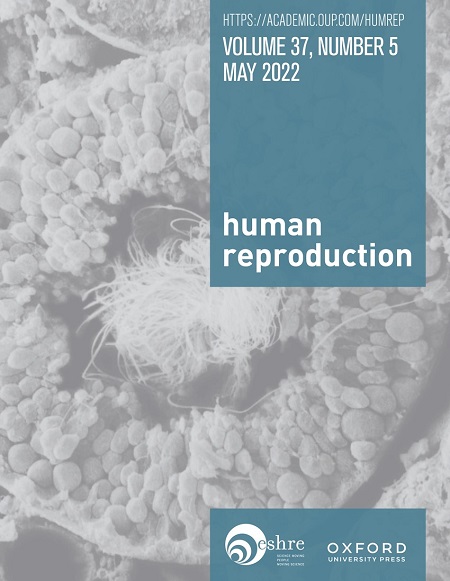The presence, clarity, and consistency of definitions in pregnancy outcomes in infertility trials: a systematic review
IF 6
1区 医学
Q1 OBSTETRICS & GYNECOLOGY
引用次数: 0
Abstract
STUDY QUESTION How frequently do infertility trials report live birth and pregnancy, and how consistently were their definitions reported? SUMMARY ANSWER One-third of 1425 infertility trials published in the last decade reported live birth, with one in eight reporting clinical pregnancy, ongoing pregnancy, and live birth concurrently; absent, ambiguous, or heterogeneous definitions were common. WHAT IS KNOWN ALREADY Absent or inconsistent outcome definitions in randomized controlled trials (RCTs) limit their interpretation and complicate subsequent evidence synthesis. While reporting live birth in infertility trials has been a long-running recommendation, the extent to which this is adhered to, and the temporal trend of adherence, is unclear. Furthermore, it is unknown if outcome reporting in infertility trials is clear and consistent. STUDY DESIGN, SIZE, DURATION We studied all RCTs in infertility published between 2012 and 2023. We aimed to assess (i) whether biochemical pregnancy, clinical pregnancy, ongoing pregnancy, and live birth were reported; the temporal trends in reporting these pregnancy outcomes, and compare the characteristics of trials reporting each type of outcome; (ii) whether and how these pregnancy outcomes were defined. PARTICIPANTS/MATERIALS, SETTING, METHODS We systematically searched Embase, Medline, and CENTRAL for RCTs in infertility from January 2012 to August 2023. RCTs involving infertile women that reported either biochemical pregnancy, clinical pregnancy, ongoing pregnancy, or live birth were eligible. Secondary analyses, interim analyses, or conference abstracts were not eligible. Two authors independently screened articles. We extracted pregnancy definitions and trial characteristics primarily using text mining in R, a programming environment for data analysis, and supplemented by manual checking. The accuracy of extracted data was validated in a random sample of 50 articles, with sensitivity and specificity all at or above 90%. MAIN RESULTS AND THE ROLE OF CHANCE We included 1425 infertility RCTs. Among these, 419 (29.4%) reported biochemical pregnancy. While 1359 (95.4%) RCTs reported clinical pregnancy, 404 (28.4%) reported ongoing pregnancy, and 484 (34.0%) reported live birth, only 174 (12.2%) reported all three outcomes. The proportion of trials reporting live birth increased from 23.1% in 2012 to 33.7% in 2023. Trials reporting up to biochemical pregnancy or clinical pregnancy were more likely to be unregistered, smaller, single-centered, and published in non-first quarter journals. Definitions for biochemical, clinical, ongoing pregnancy, and live birth were provided in 68.5% (287/419), 64.5% (876/1359), 70.5% (285/404), and 41.1% (199/484) of articles reporting on these outcomes. Among 876 clinical pregnancy definitions, 63.4% (n = 555) specified the pregnancy confirmation timing. Of the 220 definitions that reported gestational weeks (ranging from 4 to 16 weeks), the most common cut-off was 6 weeks, used in 48.2% (n = 106) of cases. For ongoing pregnancy definitions, 96.1% (n = 274) of the 285 definitions included gestational age in weeks (ranging from 6 to 32 weeks), with 12 weeks being the most common cut-off used in 49.1% (n = 140) of definitions. Among 199 live birth definitions, 62.3% (n = 124) used a gestational age threshold (ranging from 20 to 37 weeks), with 24 weeks being the most common cut-off, used in 28.6% (n = 57) of trials. LIMITATIONS, REASONS FOR CAUTION Due to the vast data we needed to extract, we used text-mining supplemented by manual data extraction. While we optimized the text-mining algorithm attempting to identify all types of outcome definitions and manually curated all extracted definitions, definitions were missed in less than 10% of randomly checked studies, which is a limitation of this study. We only described definition patterns in published RCTs, and our results cannot be extrapolated to unpublished RCTs. WIDER IMPLICATIONS OF THE FINDINGS Despite long-standing recommendations to report live birth in infertility trials, in the last decade only a third of RCTs did so. This highlights a disconnection between the advocated outcome and what researchers are reporting. We observed an encouraging trend that there has been a consistent rise in the proportion of trials reporting live birth. Furthermore, the significant lack and variability of pregnancy definitions underscore the imperative to increase the dissemination and uptake of standardized pregnancy outcomes. STUDY FUNDING/COMPETING INTEREST(S) No funding was received for the study. Q.F. reports receiving a PhD scholarship from Merck. B.W.M. is supported by an NHMRC Investigator grant (GNT1176437). B.W.M. reports consultancy, travel support, and research funding from Merck and consultancy for Organon and Norgine. B.W.M. holds stock from ObsEva. W.T.L. is supported by an NHMRC Investigator grant (GTN2016729). W.L.L. reports receiving a PhD scholarship from the China Scholarship Council. T.D.H and S.L. are employees of Merck Healthcare KGaA, Darmstadt, Germany. R.W. is supported by an NHMRC Investigator grant (GTN2009767). The other author has no conflict of interest to declare. REGISTRATION NUMBER CRD42024498624.不孕症试验中妊娠结局定义的存在、清晰和一致性:一项系统综述
研究问题:不孕症试验报告活产和妊娠的频率有多高?它们的定义报告的一致性如何?在过去十年中发表的1425项不孕症试验中,有三分之一报告了活产,其中八分之一报告了临床妊娠、持续妊娠和活产同时发生;缺失的、模糊的或异构的定义是常见的。在随机对照试验(RCTs)中缺乏或不一致的结局定义限制了它们的解释,并使后续的证据合成复杂化。虽然在不孕症试验中报告活产一直是一项长期的建议,但这一建议的遵守程度和遵守的时间趋势尚不清楚。此外,不孕症试验的结果报告是否清晰一致尚不清楚。研究设计、规模、持续时间我们研究了2012年至2023年间发表的所有不孕症随机对照试验。我们的目的是评估(i)是否有生化妊娠、临床妊娠、持续妊娠和活产的报道;报告这些妊娠结局的时间趋势,并比较报告每种结局的试验的特征;(ii)是否以及如何定义这些妊娠结局。参与者/材料、环境、方法我们系统地检索了Embase、Medline和CENTRAL从2012年1月到2023年8月的不孕症rct。包括生化妊娠、临床妊娠、持续妊娠或活产的不孕症妇女的随机对照试验符合条件。二次分析、中期分析或会议摘要不符合条件。两位作者独立筛选文章。我们主要使用R(用于数据分析的编程环境)中的文本挖掘来提取妊娠定义和试验特征,并辅以人工检查。在50篇文章的随机样本中验证了提取数据的准确性,敏感性和特异性均在90%以上。主要结果和偶然性的作用我们纳入了1425项不孕症随机对照试验。其中419例(29.4%)为生化妊娠。1359项(95.4%)rct报告了临床妊娠,404项(28.4%)报告了持续妊娠,484项(34.0%)报告了活产,只有174项(12.2%)报告了所有三种结局。报告活产的试验比例从2012年的23.1%增加到2023年的33.7%。报告生化妊娠或临床妊娠的试验更有可能是未注册的、规模较小的、单中心的、发表在非第一季度期刊上的。生化、临床、持续妊娠和活产的定义分别在68.5%(287/419)、64.5%(876/1359)、70.5%(285/404)和41.1%(199/484)报道这些结局的文章中提供。在876个临床妊娠定义中,63.4% (n = 555)明确了妊娠确认时间。在报告妊娠周数(从4周到16周)的220个定义中,最常见的截止日期为6周,在48.2% (n = 106)的病例中使用。对于持续妊娠的定义,285个定义中96.1% (n = 274)包括胎龄周(从6周到32周),其中49.1% (n = 140)定义中最常用的截止时间是12周。在199个活产定义中,62.3% (n = 124)使用胎龄阈值(从20周到37周不等),其中24周是最常见的临界值,在28.6% (n = 57)的试验中使用。由于我们需要提取大量的数据,我们使用了文本挖掘和手动数据提取。虽然我们优化了文本挖掘算法,试图识别所有类型的结果定义,并手动整理了所有提取的定义,但在随机检查的研究中,只有不到10%的定义被遗漏,这是本研究的局限性。我们只描述了已发表的rct中的定义模式,我们的结果不能外推到未发表的rct中。尽管长期以来建议在不孕症试验中报告活产,但在过去十年中,只有三分之一的随机对照试验这样做了。这凸显了所倡导的结果与研究人员报告的结果之间的脱节。我们观察到一个令人鼓舞的趋势,即报告活产的试验比例持续上升。此外,妊娠定义的显著缺乏和可变性强调了增加标准化妊娠结果的传播和吸收的必要性。研究经费/竞争利益(S)本研究未获资助。q.f报告获得了默克公司的博士奖学金。本研究由NHMRC研究者资助(GNT1176437)。B.W.M.报告了默克公司的咨询、差旅支持和研究经费,以及奥加纳和诺津公司的咨询。B.W.M.持有ObsEva的股票。w.t.l由NHMRC研究者资助(GTN2016729)。W.L.L. 获中国国家留学基金委博士奖学金。t.d.h.和S.L.是德国达姆施塔特默克医疗保健公司的员工。R.W.由NHMRC研究者资助(GTN2009767)。另一位作者没有利益冲突需要申报。注册号crd42024498624。
本文章由计算机程序翻译,如有差异,请以英文原文为准。
求助全文
约1分钟内获得全文
求助全文
来源期刊

Human reproduction
医学-妇产科学
CiteScore
10.90
自引率
6.60%
发文量
1369
审稿时长
1 months
期刊介绍:
Human Reproduction features full-length, peer-reviewed papers reporting original research, concise clinical case reports, as well as opinions and debates on topical issues.
Papers published cover the clinical science and medical aspects of reproductive physiology, pathology and endocrinology; including andrology, gonad function, gametogenesis, fertilization, embryo development, implantation, early pregnancy, genetics, genetic diagnosis, oncology, infectious disease, surgery, contraception, infertility treatment, psychology, ethics and social issues.
 求助内容:
求助内容: 应助结果提醒方式:
应助结果提醒方式:


